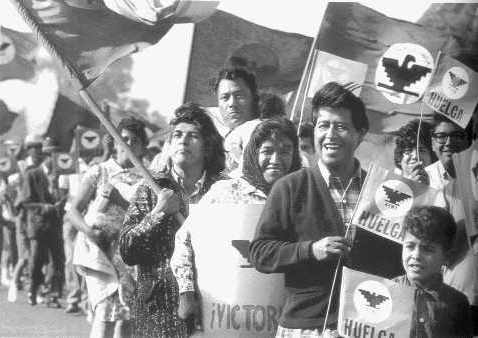The last week of March is a time of remembrance and reflection regarding Cesar Chavez and his struggles to establish the United Farm Workers (UFW). The new generation of students must learn about the sacrifices that were made to improve the lives of farmworkers.
In 2014, President Barack Obama formally designated March 31 as Cesar Chavez Day, it is now a U.S. federal commemorative holiday (this means that federally, the day is recognized, but federal offices remain open for business). In California, state offices and schools are closed on Cesar Chavez Day. March 31 also offers an opportunity to teach our students about the sacrifices that were made by Cesar Chavez, who worked tirelessly to improve the lives of migrant workers.
We celebrate Cesar Chavez Day, but we must ask ourselves a question: does the new generation truly know who Cesar Chavez was and what he did to improve our society? Where is the next Cesar Chavez?
That is why I felt it was important to write this column to reflect on the legacy of Cesar Chavez and to challenge young students to step up and lead on various social issues.
Chavez was born on March 31, 1927, in Yuma, Arizona. He worked in the fields along with his parents and siblings in California. He served in the U.S. Navy for two years and then returned to the fields.
In the 1950s, he became an organizer (a much-maligned profession) with the Community Service Organization, and in 1962, he co-founded, with Dolores Huerta, the National Farm Workers Association, which later became the United Farm Workers – UFW With his commitment to nonviolence and his hunger strikes, Chavez drew national attention to the plight of farmworkers and was instrumental in bringing them a modicum of justice.
While alive, Cesar Chavez was intensely hated and vilified by the agricultural growers, and The Teamsters union did everything in its power to undermine and demonize Cesar Chavez and his followers. The Teamsters did not trust or see Chavez as an ally since he created his own union to specifically represent the needs of the farmworkers.
What kept Cesar strong? He had an unbreakable belief in Catholic spirituality and a true commitment to social justice. He implemented powerful images of the UFW logo in his historic marches and hunger strikes. His supporters also carried the image of the Virgen de Guadalupe in the UFW marches, demanding better wages and other worker related benefits.
Even as we celebrate his legacy on March 31, we should remember that he was quite controversial while alive. We also have to point out that he was not a saint. He was a human being with flaws like anyone else.
Chavez was seen by some as a rabble-rouser and trouble maker. He chose not to follow certain established rules. And he denounced inhumane laws and practices. He was willing to fight for the invisible people. Chavez had an extraordinary connection and commitment to farmworkers.
In fact, the Filipino workers helped to revolutionize Chavez since many had already led the way in organizing and migrant worker strikes in California. Labor rights activist Larry Itliong, was the leader of the 1965 Delano Grape Strike – setting the example for others to follow – eventually, both Latino and Filipino farmworkers joined forces.
Chavez decided to take on the farmworker fight, full time, for respect and equality and created coalitions/alliances with diverse community members and farm workers. He chose to give his life for La Causa – The Cause/The Struggle.
He most enjoyed spending time with the downtrodden and going door to door to organize. He learned key organizing strategies from Fred Ross Sr., who was part of the Industrial Areas Foundation, a historic community organizing institution that originated in Chicago.
Chavez made the powerful uncomfortable. And he sacrificed his health in doing so – especially with the hunger strikes. He did not sell out. No one was able to buy Chavez, and he shunned material possessions and wealth. He was an original minimalist, who did not pursue or admire material or monetary wealth.
Of course, he was not perfect. For instance, Chavez was not fully supportive of undocumented immigrants. He was not enamored of Central American and other undocumented immigrants who allegedly had communist leanings or those he perceived as a threat to farmworkers who were here in the U.S. legally. In some ways, he remained conservative, but he believed in social justice. What is also interesting is that some migrant workers within the United Farm Workers (UFW) were Central American but were perceived to be Mexican or Chicano. Some opted to become Chicanas/os.
Overall, Chavez’s efforts made a huge difference. Chavez showed all of us how powerful we can be if we stand up for our beliefs, even if it means breaking the rules, even if it means risking our lives.
Therefore, it is up to the new generation of young students to learn from Cesar Chavez to continue his legacy and the struggle for social justice.
Let me end with this question for our students to ponder: where is the next Cesar Chavez?
Randy Jurado Ertll is the author of the recent released illustrated book The Adventures of El Cipitio: Las aventuras del Cipitio. His author web-site is WWW.RANDYJURADOERTLL.COM.
Randy Jurado Ertll
Latest posts by Randy Jurado Ertll (see all)
- La Batalla del Libro de Estudios Étnicos: Segunda Parte - April 6, 2021
- La Batalla de Libros de Estudios Étnicos: Primera Parte - April 1, 2021
- The Ethnic Studies Book Battle: Part Two - March 30, 2021
- The Ethnic Studies Book Battle: Part One - March 24, 2021
- Es Hora Que los Padres, Estudiantes y Maestros Sustitutos Creen Sus Propios Sindicatos Laborales - February 25, 2019

